Robus YouTube Video Follow-up
@davidthomasmartin1075 left a comment at the video here.
Ah c’mon now Arthur. Not so long ago now you were raving about the Induro tripod. So much so that I actually took your advice and went and spent a heck of a lot of money and bought one with great shipping expense. Eventually it transpired that Induro was the American equivalent to Benro which was a fraction of the cost. I was so annoyed to discover that.
A great tripod, don’t get me wrong and I still use it before any other but now, as a result I find it difficult to believe anything I see now on YouTube.
I really enjoy your photography and your technique and I will continue to watch your videos. I thank you for that.
Are you paid to recommend products? How does that work? Do you get equipment free to keep on your recommendations? None of my business perhaps.
I just wanted to say that it would be best to inform people of product similarities to other manufacturers products in order to make people aware that they have other options. Comparison’s should be made and mentioned. Thank you for all your advice.
My Reply (@arthurmorris4932)
@davidthomasmartin1075. You are free to believe what you want. I first started with the Induro GIT 304L in 2014. 11 years ago. It was then the best option. And they were always priced far lower than the Gitzos or Really Wrong Stuff tripods. And the MacGroup offered decent repair service. Then they went out of business. As it says in the title, “right now,” Robus is the best available and the leg locks are far superior to anything else out there at any time past or present. For the past three decades at least, BIRDS AS ART had done well because of the (hard-earned) trust that folks have placed in me and the information that I provide. with love, artie.
ps: I just read the rest of your comment. Thanks for your kind words about my educational videos. I would recommend that you visit and subscribe to my blog at www.BIRDSASRT-Blog.com. I am not paid to review products by Robus or anyone else.And since you asked, I never received a penny from The Mac Group, AKA, Induro. In fact, for my kind words I was black-balled from becoming an Induro dealer by a camera store owner from New England. Continuing one, yes, I get to keep stuff that I review. As far as I can figure, I did mention the other top brands. Gitzo has totally gone down the tubes over the past decade and Really Wrong Stuff costs 2-3X as much as Robus. The later is a quality product, but is not as good as Robus. Even worse, not that you asked, are their BH-55 ballheads; . When compared to the Levered-Clamp FlexShooter Pro heads they should best be used a deep water cod fishing sinkers.
What’s Up?
Photograph at ILE continues to thrill me every morning. Yesterday (Monday) I was able to get out of my vehicle to photograph Black-bellied Whistling Ducks from a ground level perspective using variations of the toe-pod technique with the Sony 400-800mm G lens.
Today is Tuesday 6 May 2025 and I will of course be headed down to the lake as soon as I hit Publish. Whatever you plan on doing, I hope that you too opt to have a wonderful day. Do remember that happiness is a choice — Byron Katie, The Work.Com.
If an item — a Delkin flash card, or a Levered-clamp FlexShooter Pro head — for example, that is available from B&H and/or Bedfords, is also available in the BAA Online Store, it would be great, and greatly appreciated, if you would opt to purchase from us. We will match any price. Please remember also to use my B&H affiliate links or to earn 3% cash back at Bedfords by using the BIRDSASART discount code at checkout for your major gear purchases. Doing either often earns you free guides and/or discounts. And always earns my great appreciation.
Supporting My Efforts Here
If you enjoy and learn from the blog, are all set for gear, or live overseas, consider leaving a BAA Blog Thank You Gift here.
If you enjoy and learn from the blog, please consider using one of my affiliate links when purchasing new gear. It will never cost you a single penny. To support my effort here, please order from B&H by beginning your search here. Or, click here, to order from Bedfords and enter the discount code BIRDSASART at checkout to receive 3% cash back to your credit card and enjoy free Second-Day Air Fed-Ex shipping. It is always best to write for advice via e-mail.
In many cases, I can help you save some serious dollars. And/or prevent you from purchasing the wrong gear from the wrong shop. And with many items, you can earn a free BAA Gear Guide by using one of my affiliate links.
Flight Photography at Jacksonville Till You Can’t Lift Your Lens!
Join me on the beach at Huguenot Memorial Park to learn about photographing terns and gulls. With 40 to 50,000 birds at the location, there is always lots of flight action. Learn about how the relationship between the wind and the sun impacts flight photography and about how best to use your gear for shooting birds in flight.. Note that all the images in the video were created with the Sony a1 (and a variety of lenses). Join me on a workshop at Jacksonville this summer. See the details below.
|
|
|
Clockwise from upper left corner around to center: ink-stained Royal Tern with squid for chicks; fluffy white Royal Tern Chick about two weeks old; Royal Tern with shrimp for chicks; 3-4 week old Royal Tern chick; incoming adult Royal Tern with greenback; Royal Tern in flight with juvenile mahi-mahi; large Brown Pelican chick preening; field guide portrait of fresh juvenile Laughing Gull; Royal Tern chick begging for fish from incoming adult. Join me at Huguenot Memorial Park this Summer |
The 2025 Jacksonville, FL Royal Terns and more With Chicks Extended IPT
June 26 – July 6, 2025. Limit four photographers; openings three
I have an AirBnB checking in on the late afternoon of Thursday 26 June and checking out on Sunday 6 July 2025. If you are looking to improve your bird photography by leaps and bounds, consider joining me. I have room for one more person at the AirBnB and for one more person in my vehicle. Instruction is available on a sliding scale; the longer you stay, the lower the daily rate. For pricing and AirBnB INFO, please shoot me an e-mail. Out of town folks can fly in and out of Jacksonville International Airport (JAX).
|
|
|
Clockwise from upper left corner around to center: Royal Tern chick feeding frenzy; Royal Tern nearly fledged chick; ink-stained Royal Tern with squid for chicks; Royal Tern chick begging; Brown Pelican immature tight flight; Royal Tern adult screaming — tight flight; Laughing Gulls mobbing Royal Tern to steal fish; Royal Tern with fish for chicks. Join me at Huguenot Memorial Park this Summer |
Huguenot Memorial Park in Early Summer
Driving on the beach at Huguenot Memorial Park in early summer is a bird photographer’s delight. You park this side of the last rope on the beach and you are within 100 yards of the Royal Tern colony atop the dunes. There are also tens thousand pairs of Laughing Gulls and a few Sandwich Terns breeding as well. In some years, there are some Brown Pelican nests on the ground! .
In late June and early July, the tern chicks begin to make their way down to the flats to bathe and drink in tidal pools and the Atlantic Ocean and get fed by the parents. On the way, they spend a lot of time on the face of the dune where they are easy to photograph at eye level. They may also gather in fairly large groups at the base of the dunes.
Flight photography both in the mornings and the afternoons can be quite excellent as the terns are carrying all manner of marine life to sustain the rapidly growing chicks: the adults are often seen flying around in search of their chicks with all sorts of small baitfish as well as immature fish, large shrimps, baby crabs, and even squid in their bills. The squid will squirt ink on the tern’s breast’s in protest. So if you see an adult Royal Tern flying around with a black necklace you can understand why.
I first visited the beach nesting bird colony at Jacksonville in late June 2021. I was astounded. There were many thousands of pairs of Royal Terns nesting along with about 10,000 pairs of Laughing Gulls. In addition to the royals, there were some Sandwich Terns nesting. And there were several dozen pairs of Brown Pelicans nesting on the ground. Flight photography was non-stop astounding. And photographing the tern chicks was relatively easy. Folks could do the whole trip with the Sony 200-600, the Canon 100-500 RF, or the Nikon 500 PF or one of the many new Z telephoto lenses or zooms. Most of the action is within 100 yards of where we park (on the beach). As with all bird photography, there are times when a super-telephoto lens with either TC is the best tool for the job.
Morning sessions will average about three hours, afternoon sessions at least 1 1/2. On cloudy mornings with favorable winds, we may opt to stay out for one long session in the morning and skip the afternoon, especially when the afternoon weather forecast is poor. Brunch and daily image review and Photoshop sessions are included on all but the last day of your stay and will take place at my AirBnB (whether or not you opt to stay there with Vasili Chernishof and me. This year’s AirBnB is only nine minutes from the park entrance. Please note that we need to be off the beach by 7pm daily.
What You Will Learn on a Jacksonville IPT
- 1- First and foremast you will learn to become a better flight photographer. Much better.
- 2-You will learn the basics and fine points of digital exposure. Nikon and Canon folks will learn to get the right exposure every time after making a single test exposure, and SONY folks will learn to use Zebras so that they can be sure of making excellent exposures before pressing the shutter button.
- 3- You will learn to work in Manual exposure mode even if you fear it.
- 4- You will learn to evaluate wind and sky conditions and understand how they affect bird photography, especially the photography of birds in flight.
- 5- You will learn several pro secrets (for each system) that will help you to become a better flight photographer.
- 6- You will learn to zoom out in advance (because the birds are so close!) 🙂
- 7- You will learn how to approach free and wild birds while minimizing disturbance.
- 8- You will learn to spot the good and the great situations.
- 9- You will learn to understand and predict bird behavior.
- 10- You will learn to design pleasing images by mastering your camera’s AF system.
- 11- You will learn to choose the best perspective.
- 12- You will learn to see and control your backgrounds.
- 13- You will learn to see and understand the light.
- 14- You will learn to see and create pleasing blurs in pre-dawn situations.
- 15- You will learn to be ready for the most likely event.
And the best news is that you will be able to take everything you learn home with you so that you will be a better photographer wherever you are and whenever you photograph.
Flight Photography at Jax
There is a ton of great flight photography at Huguenot. You can use a handheld intermediate telephoto lens or a faster, longer fixed focal length lens mounted on a tripod with a Levered-Clamp FlexShooter Pro. We will get to photograph the Royal and Sandwich Terns, Laughing and other gulls, and Brown Pelicans, all in flight on most days.
Lenses for Flight Photography at Jax
While a handheld or tripod mounted 500 or 600mm f/4 lens can be quite useful for flight photography on the beach, handhold-able intermediate and zoom telephoto lenses like the Sony 200-600mm or the 400-800 G lenses, the Canon RF 100-500 or 200-800, and any one of the Nikon intermediate telephoto or zoom lenses can often be the ticket to success when flight shooting. I did quite well on my last visit handholding the Sony 300mm f/2.8 GM lens usually with the 1.4X teleconverter.
Consider changing your life by joining me at Jacksonville in late June 2025.
|
|
|
This image was created on 17 July 2024 at Huguenot Memorial Park on the 2024 Jacksonville IPT. Standing at full height, I used the hand held Sony FE 300mm f/2.8 GM OSS Lens (Sony E) with the Sony FE 1.4x Teleconverter and the ridiculously amazing Sony a9 III Mirrorless Camera. The exposure was determined via Zebra technology with ISO on the Thumb Dial. ISO 1600: 1/4000 sec. at f/4 (wide open) in Manual mode. When evaluated in RawDigger, the raw file brightness was determined to be perfect. AWB at 5:38:51pm on a cloudy afternoon. Tracking Zone/AF-C with Bird Face/Eye detection enabled performed to perfection. Be sure to click on the image to enjoy the larger, inexplicably sharper high-res version. Image #1: Royal Tern/post-breeding adult in flight with baitfish for chicks |
Flight Photography on a Jacksonville IPT
With about 8000 pairs of Royal Terns, 10,000 pairs of Laughing Gulls, and several dozen pairs of Sandwich Terns, there are birds in the air all the time, often carrying various types of fish and crabs and other invertebrates for their young. There is, of course, a ton of flight photography. The best news on that is that you do not need a long, heavy super-telephoto lens to succeed. All of today’s featured images were created at 420mm. Any mid-length or zoom telephoto lens will be quite adequate. Heck, on the 2024 IPT, Sandra Calderbank made some excellent flight shots with her lightweight, hand held Sony 70-200mm f/2.8 GM II lens and her a-1 (with either teleconverter).
|
|
|
This image was also created on 17 July 2024 at Huguenot Memorial Park on the 2024 Jacksonville IPT. Again, standing at full height, I used the hand held Sony FE 300mm f/2.8 GM OSS Lens (Sony E) with the Sony FE 1.4x Teleconverter and the ridiculously amazing Sony a9 III Mirrorless Camera. The exposure was determined via Zebra technology with ISO on the Thumb Dial. ISO 1600: 1/3200 sec. at f/4 (wide open) in Manual mode. When evaluated in RawDigger, the raw file brightness was determined to be perfect. AWB at 5:47:47pm on a cloudy afternoon. Tracking Zone/AF-C with Bird Face/Eye detection enabled performed to perfection. Be sure to click on the image to enjoy the larger, inexplicably sharper high-res version. Image #2: Laughing Gull fledged flying young in flight |
Wing Positions
With the latest high-end mirrorless camera bodies offering superb AF system, there is a lot more to making successful flight photos than having the bird in the frame and the eye sharp. It is the wing positions and flight poses that make or break good flight shots.
Image #1 features a decent wings down flight pose with the bird angling slightly toward us and a good look at the near dorsal wing detail. Image #2 has the bird angling 45° toward us. With the wings fully raised, we have a nice look at the near underwing detail and the dorsal surface of the far wing. Image #5 also has the bird angling toward us and with the bird relatively high in the sky we have a nice view of both underwings.
|
|
|
This image was created on 17 July 2024 at Huguenot Memorial Park on the 2024 Jacksonville IPT. Seated on dry sand using the knee–pod technique, I used the hand held Sony FE 300mm f/2.8 GM OSS Lens (Sony E) with the Sony FE 1.4x Teleconverter and the ridiculously amazing Sony a9 III Mirrorless Camera. The exposure was determined via Zebra technology with ISO on the Thumb Dial. ISO 1250: 1/2500 sec. at f/4 (wide open) in Manual mode. When evaluated in RawDigger, the raw file brightness was determined to be dead-solid perfect. AWB at 6:32:36pm on a cloudy afternoon. Tracking Zone/AF-C with Bird Face/Eye detection enabled performed to perfection. Be sure to click on the image to enjoy the high-res version. Image #3: Royal Tern/half-grown chick begging |
When I Am Feeling Lazy
When I am feeling lazy at JAX, I will often leave the 600mm f/4 and the 400mm f/2.8 in the rear compartment of my SUV and grab the far lighter 300mm f/2.8 GM lens with the 1.4X TC in place. No tripod, no worries, and the 420mm makes a great lens for flight in addition to being an excellent chick lens. I can’t wait for some clouds this season so that I can go to my a-1 ii that allows for lots more pixels on the subject and thus larger crops with much higher image quality than with the a9 III.
At f/4, the 300 with the 1.4X TC excels on cloudy days when compared to the much slower zoom lenses.
|
|
|
This image was also created on 17 July This image was also created on 17 July 2024 at Huguenot Memorial Park on the This image was also created on 17 July 2024 Jacksonville IPT. Again, seated on dry sand using the knee–pod technique, I used the hand held Sony FE 300mm f/2.8 GM OSS Lens (Sony E) with the Sony FE 1.4x Teleconverter and the ridiculously amazing Sony a9 III Mirrorless Camera. The exposure was determined via Zebra technology with ISO on the Thumb Dial. ISO 2000: 1/2500 sec. at f/5.6 (stopped down one stop!) in Manual mode. When evaluated in RawDigger, the raw file brightness was determined to be dead-solid perfect. AWB at 6:39:03pm on a cloudy afternoon. Tracking Zone/AF-C with Bird Face/Eye detection enabled performed to perfection. Be sure to click on the image to enjoy the high-res version. Image #4: Royal Tern/fledged and flying chick on beach |
My Absolute Favorite Chick Plumage
Royal Tern chicks of all ages feature a great variety of plumages and color schemes. The very small chicks may be pure white or pure gray and there are even some blonde ones. As they age, the feathering changes rapidly. The large chicks may be on the plain side as seen in Image #3 but again, there are lots of variations. I call my favorite plumage at that stage “bright checkerboard” for the neat pattern of the back feathers. The more contrasty, the better.
|
|
|
This image was created on 18 July 2024 at Huguenot Memorial Park on the 2024 Jacksonville IPT. Standing at full height, I used the hand held Sony FE 300mm f/2.8 GM OSS Lens (Sony E) with the Sony FE 1.4x Teleconverter and the ridiculously amazing Sony a9 III Mirrorless Camera. The exposure was determined via Zebra technology with ISO on the Thumb Dial. ISO 640: 1/4000 sec. at f/5 (stopped down 2/3-stop) in Manual mode. When evaluated in RawDigger, the raw file brightness was determined to be dead solid perfect. AWB at 7:45:43am on a variably sunny morning. Tracking Zone/AF-C with Bird Face/Eye detection enabled performed to perfection. Be sure to click on the image to enjoy the larger, inexplicably sharper high-res version. Image #5: Sandwich Tern/post-breeding adult in flight with storm cloud background |
Storm Clouds!
If the wind is right, I get excited by the presence of dark storm clouds as they provide dramatic backgrounds for white birds in flight. And early summer at Huguenot Memorial Park is prime time for thunderstorms and dark clouds. As you park on the beach only yards from the action, safety from lighting is never far away. When you see lightning, get into your car ASAP. No image is worth getting fried.
Typos
With all blog posts, feel free to e-mail or to leave a comment regarding any typos or errors.

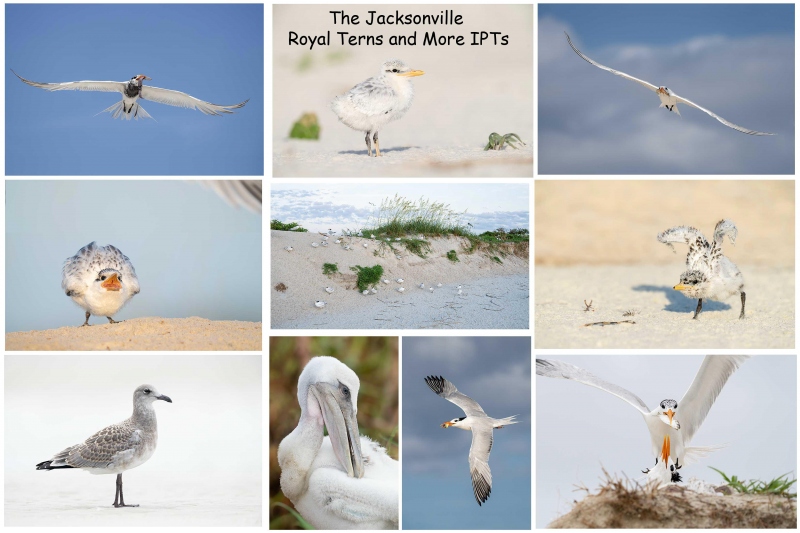
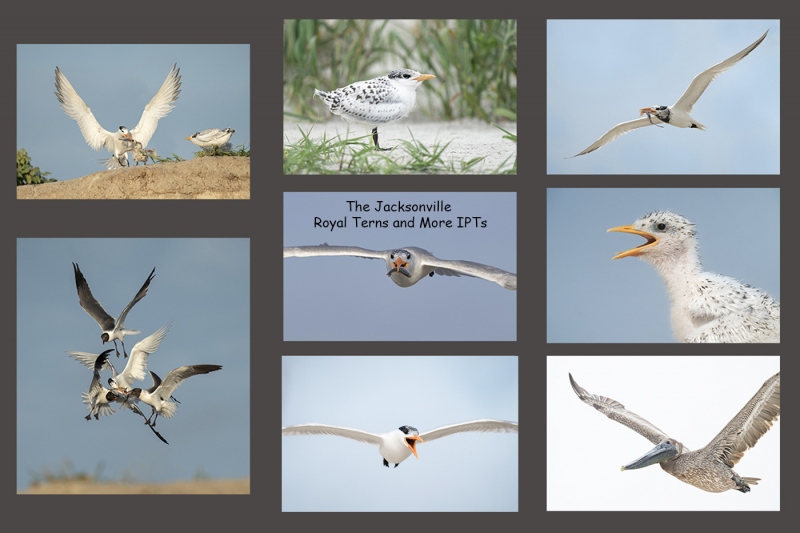
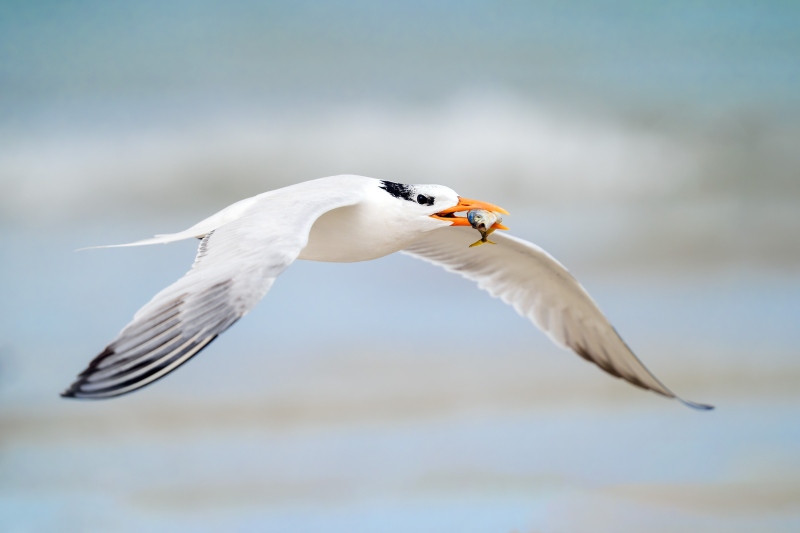
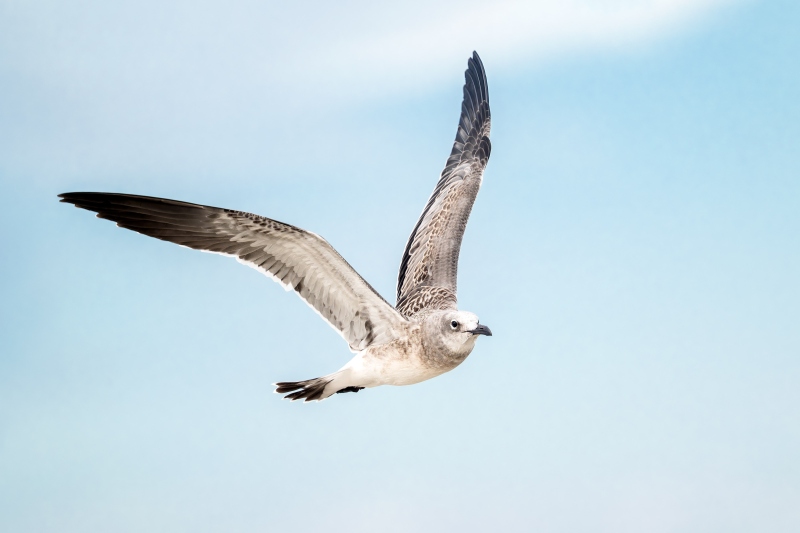
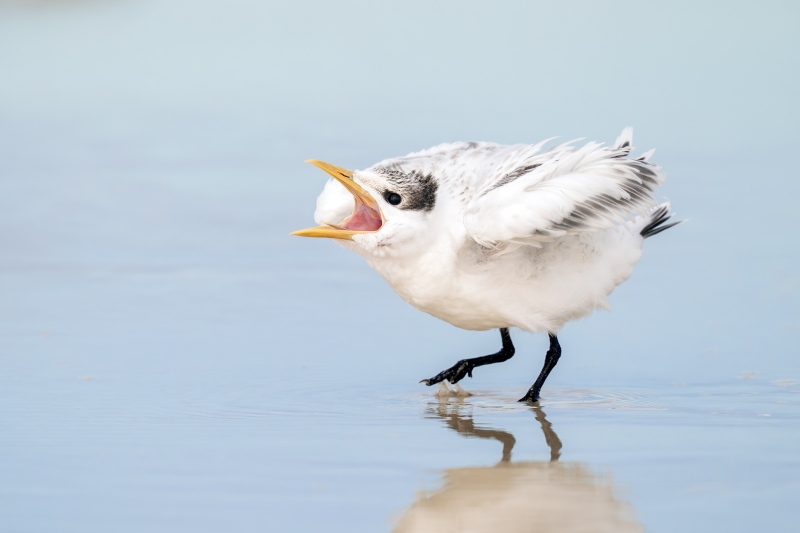
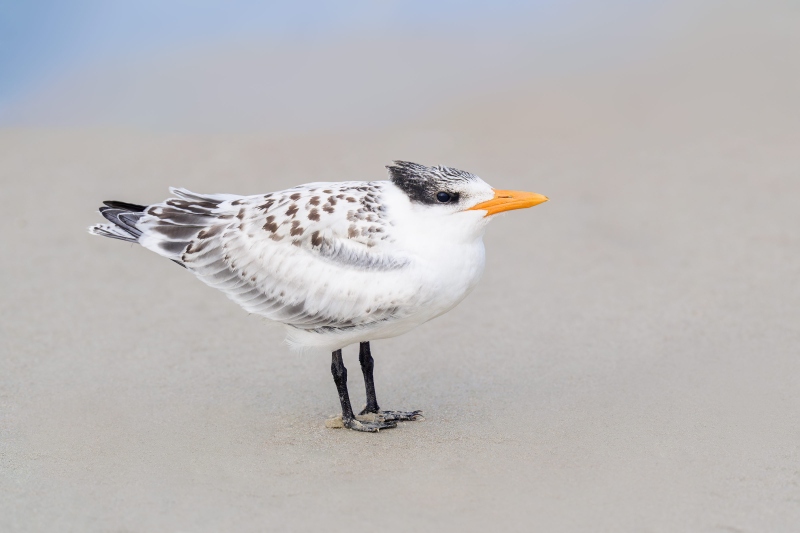
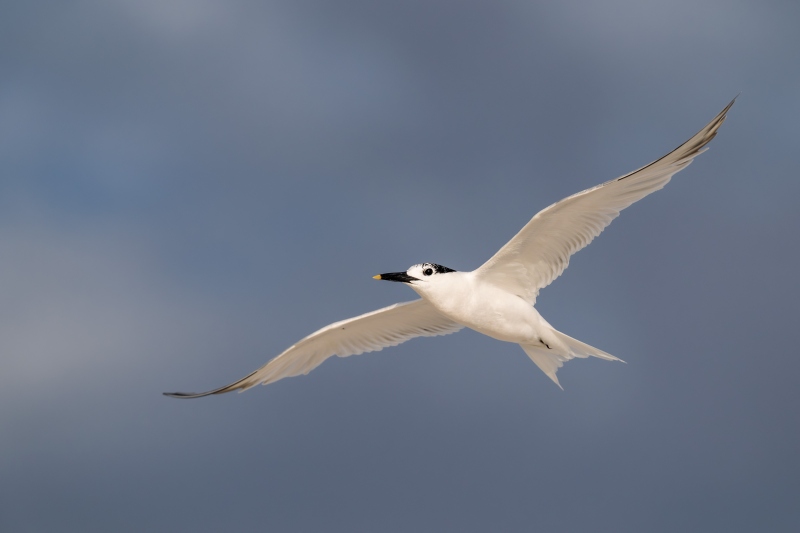






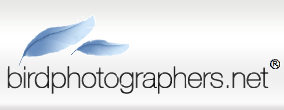


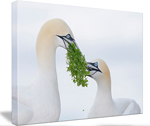



Leave a Reply